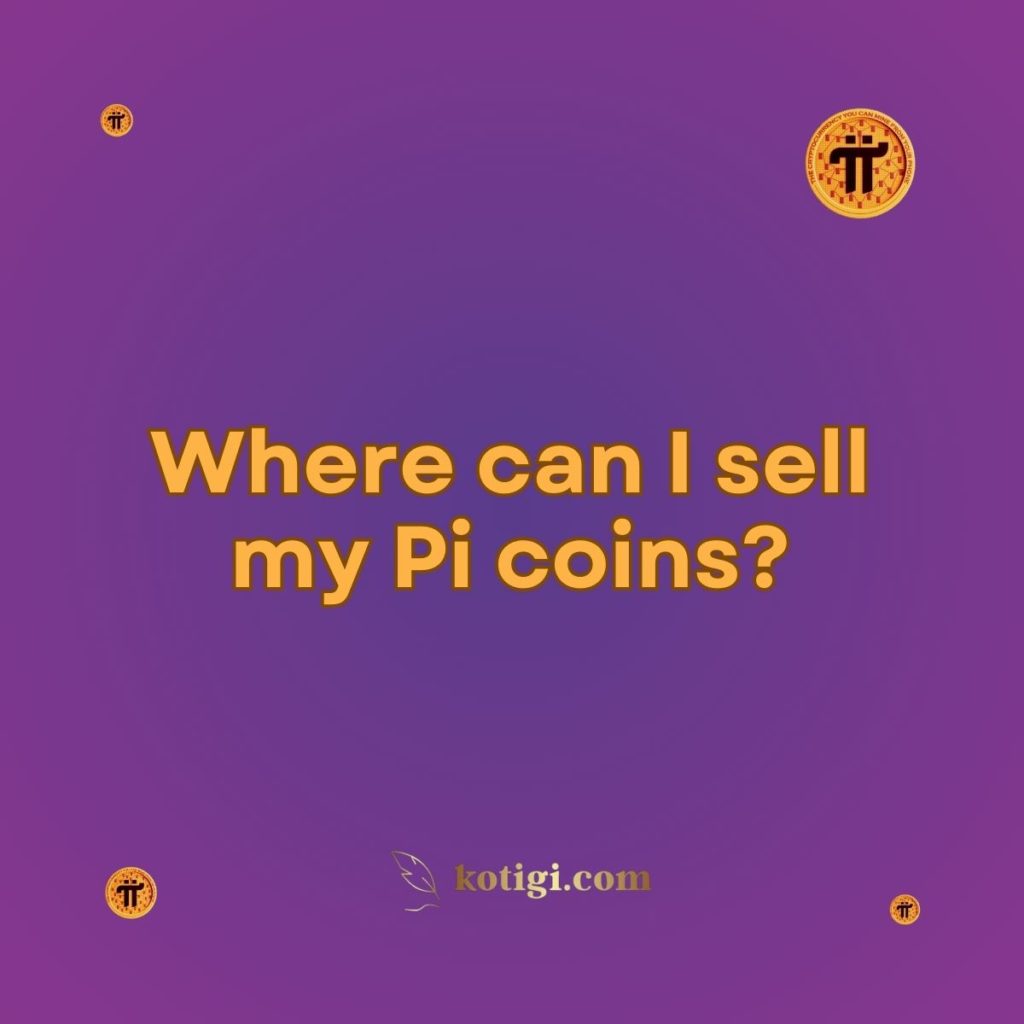
Where can I sell my Pi coins?
As of now, Pi coins cannot be sold on external cryptocurrency exchanges due to the network being in its enclosed mainnet phase. Once Pi Network transitions to an open mainnet and Pi is listed on exchanges, users will be able to sell their coins. However, currently, Pi can only be used within the network for goods and services in select marketplaces.
Introduction
Pi Network has attracted millions of users worldwide with its innovative approach to mobile mining and the promise of future utility. One of the most common questions asked by Pi miners is, “Where can I sell my Pi coins?” Given Pi’s current stage of development, the answer is not straightforward. In this article, we’ll explore the current state of Pi Network, its future potential, and what to expect regarding the ability to sell Pi coins.
Understanding Pi Network’s Current Stage
Enclosed Mainnet and Its Implications
Pi Network is currently in what’s known as the “enclosed mainnet” phase. This means that while users can mine Pi and engage in certain activities within the network, Pi coins cannot yet be traded on external cryptocurrency exchanges. This phase is critical for the Pi Network team to focus on important aspects like improving the network’s security, ensuring KYC (Know Your Customer) compliance, and preparing for the eventual transition to the open mainnet.
The enclosed mainnet is essentially a testing and development stage, allowing the core team to monitor the network, address any issues, and solidify the foundation for future expansion. During this phase, Pi coins can only be used within the Pi ecosystem, which currently includes limited marketplaces and peer-to-peer transactions.
KYC Verification Process
Before users can sell or transfer their Pi coins, they must complete Pi Network’s KYC process. This process verifies users’ identities to ensure compliance with regulatory standards. Only those who have passed KYC will have their Pi coins transferred to the mainnet wallet, which is a prerequisite for future trading when Pi becomes available on external exchanges.
The KYC process is ongoing, and the Pi Network team is working to ensure that all legitimate users can complete this step before the launch of the open mainnet.
When Will Pi Coins Be Tradable?
Transition to the Open Mainnet
The key event that will allow Pi coins to be sold on external cryptocurrency exchanges is the transition from the enclosed mainnet to the open mainnet. In the open mainnet phase, Pi coins will have the potential to be listed on major exchanges, allowing users to buy, sell, and trade their coins.
However, there is currently no official timeline for when this transition will occur. The Pi Network team has been cautious about setting specific dates, emphasizing the need to focus on network security, scalability, and KYC completion before making the move to the open mainnet. Once this phase is complete, Pi coins are expected to be listed on various exchanges, providing users with the opportunity to trade their coins.
Pi’s Potential for Exchange Listings
Once Pi Network opens up to external exchanges, it could potentially be listed on popular platforms like Binance, Coinbase, or Kraken. These exchanges have large user bases and could provide Pi coins with liquidity and a broader audience of buyers and sellers. However, it’s essential to note that exchange listings are not automatic and require approval from the exchanges themselves.
For Pi to be listed on major exchanges, it will need to meet certain criteria, including regulatory compliance, network stability, and demand from the cryptocurrency community. While Pi’s large user base and innovative technology give it a strong foundation, it remains to be seen how quickly and widely Pi will be adopted by exchanges.
Where Can I Use My Pi Coins Right Now?
Pi Network Ecosystem
Even though Pi coins cannot currently be sold on exchanges, they can still be used within the Pi Network’s internal ecosystem. Pi Network has developed a marketplace where users can buy and sell goods and services using Pi as a currency. These marketplaces are still in their early stages but offer a glimpse of Pi’s potential utility in the real world.
Users can engage in peer-to-peer transactions, buying everything from digital goods to physical items from other Pi miners. While this is a limited use case compared to trading on global exchanges, it demonstrates that Pi already has some real-world value within its community.
Pi2Day and Other Community-Driven Initiatives
The Pi Network community has organized various initiatives, such as Pi2Day, where users celebrate Pi and participate in community-driven activities, including peer-to-peer trades. During events like these, Pi miners can exchange Pi for goods and services, further increasing the coin’s usability within the enclosed network.
These initiatives help foster a sense of community and show that Pi coins already have some level of utility, even without exchange listings. However, these activities remain small in scale compared to the global trading of cryptocurrencies like Bitcoin or Ethereum.
What to Expect When Pi Coins Become Tradable?
Value Determination on Exchanges
Once Pi coins are listed on cryptocurrency exchanges, their value will be determined by market forces, specifically supply and demand. This is when the true market value of Pi will become apparent. The large number of Pi users worldwide could generate significant interest in the coin, potentially driving up its value.
However, it’s essential to note that the price of Pi at launch will likely fluctuate. Many early adopters may seek to cash out their coins, which could create an initial surge in supply. Conversely, if there is high demand from new users and investors, the price of Pi could rise. As with any cryptocurrency, market conditions can be unpredictable, and users should be prepared for price volatility.
Regulatory Considerations
Another factor that could influence where and how Pi coins can be sold is regulatory compliance. Cryptocurrencies are subject to various regulations depending on the country or region. For Pi to be traded legally on global exchanges, it will need to comply with relevant financial regulations, including anti-money laundering (AML) and KYC requirements.
The Pi Network team has already taken steps to ensure regulatory compliance by implementing the KYC process. However, additional regulatory hurdles could arise as the network expands and becomes more integrated into global financial systems. Users should stay informed about the legal status of Pi in their respective countries to ensure they can trade their coins without legal issues.
Potential for Peer-to-Peer Sales
In addition to trading on exchanges, Pi users may engage in peer-to-peer sales of their coins. This could involve direct transactions between individuals, where one party transfers Pi to another in exchange for fiat currency or other cryptocurrencies. Peer-to-peer sales are common in the cryptocurrency space, particularly for coins that are not yet widely available on major exchanges.
However, peer-to-peer transactions carry some risks, such as the possibility of fraud or price disputes. Users should exercise caution when engaging in these types of transactions and use secure platforms or escrow services to facilitate the exchange.
The Role of Pi’s Community in Its Future Success
Community-Driven Development
One of Pi Network’s greatest assets is its large and active community. With over 40 million engaged users, the Pi community plays a crucial role in the network’s development and success. The more active and engaged the community, the higher the chances of Pi’s future growth and adoption.
The Pi community also contributes to the network’s marketplace, creating opportunities for users to buy and sell goods and services using Pi coins. This grassroots-level activity helps build Pi’s value and utility within the network, even before it becomes available on global exchanges.
Educating and Empowering Users
As the Pi Network evolves, the community will play a significant role in educating new users about the network’s potential and guiding them through the process of mining, using, and eventually selling their coins. Community-driven education and support can help attract more users to the network, further increasing demand for Pi and enhancing its long-term value.
Conclusion
At this point in Pi Network’s development, Pi coins cannot be sold on external cryptocurrency exchanges due to the network being in its enclosed mainnet phase. Once Pi transitions to the open mainnet, users will likely be able to sell their Pi coins on exchanges, where market forces will determine their value.
In the meantime, Pi coins can be used within the Pi ecosystem for peer-to-peer transactions and in select marketplaces. While this may not be the full-scale trading experience that many users are hoping for, it demonstrates that Pi already has some utility.
The future of Pi depends on several factors, including the successful completion of the KYC process, the transition to the open mainnet, and the potential for widespread adoption by businesses and exchanges. Until these milestones are reached, Pi users will need to remain patient and continue to engage with the network as it evolves.
Key Takeaways:
- Pi Network is still in its enclosed mainnet phase, so Pi coins cannot be traded on external exchanges.
- Pi coins can currently be used within the network for peer-to-peer transactions and in select marketplaces.
- Once Pi transitions to the open mainnet, users will likely be able to sell their coins on exchanges.
- The future value of Pi will depend on market demand, adoption, and regulatory compliance.
- Until the open mainnet launch, users can engage with the Pi community and ecosystem to explore existing use cases for Pi coins.




